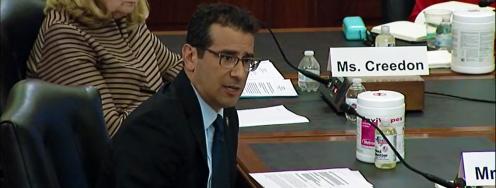New Nuclear Bomber Costs Set to Double, Spiking to $9 Billion Per Year
On the radar: LRS-B’s big hidden costs; Scrapping 3+2; Threat of nuclear terrorism in Ukraine; GOP wants to accelerate BMD to NATO; Cutting nonpro funding for Russia; Dealing with nuclear North Korea; and Prompt global arms race.
May 7, 2014 | Edited by Lauren Mladenka and Geoff Wilson
You ain't seen nothing yet - “The U.S. Air Force projects that its annual spending on long-range bombers will almost double after 2019 as it seeks a new stealth aircraft,” reports Tony Capaccio for Bloomberg. “The service’s total budget for bomber production and upgrades will jump to about $9.5 billion in fiscal 2020 from less than $5 billion for the year beginning Oct. 1, according to a Pentagon document obtained by Bloomberg News. After that, spending would remain greater than $9 billion a year before dropping to $8 billion in fiscal 2024.”
--“‘The current goal is to achieve an initial capability in the mid-2020s’ for the new Long-Range Strike Bomber while also upgrading the B-2 stealth bomber… and the older non-stealth B-1 and B-52, according to the plan that was submitted to Congress last month but had not previously been disclosed. The new bomber is described by the Air Force as vital to reaching far-flung, heavily defended targets worldwide. The service has said it may buy as many as 100 of the new aircraft in a program that may top $55 billion” Full story here. http://bloom.bg/1kX5LJ3
Rethinking the 3+2 math - “In March, the Obama administration announced it would delay key elements of its ‘3+2’ plan to rebuild the U.S. stockpile of nuclear warheads amidst growing concern about the program's high cost and its technically ambitious approach. Now, the administration and Congress should use this opportunity to reevaluate the program and shift to a more straightforward and affordable path for maintaining the U.S. nuclear stockpile. Announced last summer by the National Nuclear Security Administration (NNSA), the 3+2 strategy has a sticker price of $60 billion and calls for extending the service life of five nuclear warhead types, three of which would be ‘interoperable’ on land-based and sea-based ballistic missiles. Two other warhead types would be used on bombers, and two types would be retired.”
--“Congress, on a bipartisan basis, has been skeptical of 3+2 from the start, particularly the proposal for interoperable warheads. The Senate Appropriations Committee wrote last year that the concept ‘may be unnecessarily complex and expensive, increase uncertainty about certification’ and ‘fail to address aging issues in a timely manner.’ It is time to rethink the 3+2 plan. It is too expensive to survive in the current budget climate, takes unnecessary risks with warhead reliability, and has no clear military requirement. It is a solution in search of a problem. The good news is that we don't need 3+2. The current warhead life extension program (LEP) is successfully refurbishing warheads, and there is no need to adopt a more risky and exorbitantly expensive approach. NNSA can and should stick with the traditional path to warhead maintenance, and save tens of billions of dollars.” Read the full report from the Arms Control Association here. http://bit.ly/1mC10IE
Possible dirty domb - “Ukrainian authorities on Monday announced the seizure of radioactive material that had been smuggled into the country from a separatist region,” Global Security Newswire reports. “The Ukrainian security service's counterintelligence branch apprehended nine individuals on April 30 in the Chernivtsi region, a spokeswoman for the department said in an Interfax-Ukraine report that was translated by the BBC. The security service characterized the seized material as a ‘source of ionizing radiation which possibly contained uranium-235’ with a weight of roughly 1.5 kilograms.”
--“Security service officials are not excluding the possibility that the alleged nuclear smuggling ring was planning to construct a radiological weapon that might be detonated during public gatherings in the southeastern part of Ukraine for the purpose of fomenting political and social unrest… According to initial information, at least one Russian national and a number of Ukrainian citizens were arrested. A criminal investigation has been launched into alleged banned uses of radioactive substances.” Read the full story here. http://bit.ly/1irtGfi
Speeding up - “Senate Republicans are pushing for the U.S. military to speed up deployment of advanced interceptors in Poland to send a deterrent message to Russia,” writes Rachel Oswald in Global Security Newswire. “A bill introduced last week by Senator Bob Corker (R-Tenn.) and 22 other GOP members of his chamber would require the Obama administration to provide a plan for how to achieve deployment of Phase 3 of the ‘Phased Adaptive Approach’ for European missile defense by the end of 2016. Antimissile assets under the third phase currently are not planned for fielding in Poland until late 2018, at the earliest.”
--Some analysts question “the wisdom of pursuing any action that would seem to validate Moscow's longstanding fears about U.S. missile defense plans,” writes Oswald. "Despite the current tensions with Russia, it is not in the U.S. national interest to feed the Russian suspicion that the [European Phased Adaptive Approach] is directed at them -- an impression we have spent years trying to dispel," said Kingston Reif. Full article here. http://bit.ly/1irvc0Z
Cutting nonpro funding - “House Armed Services Committee Republicans are looking to block the Obama administration from continuing nuclear security work in Russia until the Ukraine crisis has been resolved,” reports Douglas Guarino in Global Security Newswire. “Draft defense authorization bill language released on Monday would bar the use of fiscal 2015 funds by the Energy Department's nuclear security arm ‘for any contract, cooperation, or transfer of technology’ between the United States and Russia, pending specific action by the administration.” The proposal comes amid resumed nuclear security work in Russia by the NNSA, despite disagreements over Moscow's annexation of the Crimea region in Ukraine. Get the full story here. http://bit.ly/1hx3Uqv
Tweet - @lou-reuters: IAEA team tours #Iran uranium mine, agrees on monitoring reactor -Iranian media via @reuters http://reut.rs/Qeh44e
Reactor safety in North Korea - “A new expert report recommends that Washington and other governments attempt to engage North Korea on the possible safety risks of its new reactor,” writes Rachel Oswald in Global Security Newswire. “North Korea is believed to be close to finishing construction of an experimental light-water reactor at its Yongbyon nuclear complex. In May 2013, the expert website 38 North concluded that Pyongyang could begin the nine- to 12-month process for starting up the reactor just as soon as it had produced enough nuclear fuel to operate the plant. Very little is definitively known about the reactor's design or specific capabilities, as Pyongyang has not permitted international inspections of the site.”
--“When Pyongyang first revealed its plans for the reactor in 2010, it said the facility would be used to produce atomic energy for nonmilitary purposes. The Kim Jong Un regime reversed that position last spring when it announced that it would dedicate the light-water reactor -- as well as an older graphite reactor -- to producing fissile material for its weapons program.” Read the full piece here. http://bit.ly/1fPfAcU
Tweet - @nukes_of_hazard: "North Korea’s Non-Test: Lessons from a Non-Event" @warontherocks @MiraRappHooper http://bit.ly/1qebxLG
Strategic liability - “While a territorial dispute threatens to drag China and Japan into conflict, a separate, slow-motion crisis building on the Korean peninsula could further inflame their rivalry,” writes Andrew Browne in The Wall Street Journal. “Evidence North Korea is about to pull the trigger on its fourth nuclear test underlines that the North is marching determinedly, one step at a time, toward the day when it can target any city in the Asian Pacific—and potentially large population centers in the U.S.—with nuclear attack.”
--A “fourth test would add pressure on the U.S. to bolster its missile defenses in the region—and it could bring South Korea and Japan closer to contemplating their own nuclear deterrents, separate from the U.S. This is China's nightmare: a nuclear arms race on its doorstep, and one that adds muscle to its rival Japan as the two wrangle over a set of islets in the East China Sea. But will China's leaders act? ‘They are looking at North Korea increasingly as a strategic liability rather than an asset,’ says a senior South Korean Foreign Ministry official… China still values North Korea as a buffer against U.S. forces stationed in South Korea, and it fears that a messy implosion of a nuclear-armed regime could spill chaos over its borders. In the end, the demise of a socialist ally may be too unnerving a prospect for the Chinese Communist Party, which frets about its own mortality.” Read the full article here. http://on.wsj.com/1lYgnZf
Tweet - @BulletinAtomic: The Marshall Islands lawsuit: has the time come for the NPT to be treated as internationall law? http://bit.ly/1s33IEc
Legacy of the Dyna-Soar - Originally conceived by the U.S. Defense Department in 1957 as a manned intercontinental bomber, the "dynamic soaring" aircraft -- with its black cylindrical body and delta-shaped wings -- was designed to travel at more than five times the speed of sound. The plan was to use a large rocket to blast the Dyna-Soar into space. Then, rather than arcing high above the Earth, like a ballistic missile, it would re-enter the atmosphere quickly and glide to its target, without power, for vast distances… The concept was simple, but its realization proved fiendishly difficult. In 1963, after spending more than $400 million (about $3 billion today), the Pentagon finally decided that the engineering challenges facing the Dyna-Soar were simply too expensive to overcome, and it canceled the project before the vehicle's first test.”
--“But the interest in boost-glide weapons, as they're called, never completely faded. Some 40 years after the Dyna-Soar's demise, the United States reinvigorated its efforts to develop the technology. By 2003, U.S. military planners had become worried that the country's long-range conventional weapons, such as cruise missiles, might be too slow to reach hypothetical distant targets that needed to be struck urgently… The United States has since tested such weapons, but it hasn't actually purchased them. In fact, Washington has not even decided what exactly it would use them for. Although it has already spent an estimated $1 billion on prototypes, the boost-glide weapon remains, as one Pentagon contractor put it, a ‘missile in search of a mission.’”
--“Unfortunately, China and Russia view Washington's interest in the weapons as a done deal. Consequently, both countries have begun their own research and development efforts, potentially sparking a risky new arms race… Today, the only Chinese missiles that can reach the continental United States are nuclear-armed, but the use of nuclear weapons would be credible only in the direst of circumstances. Thus, long-range hypersonic conventional weapons could represent a more usable threat -- and render the United States vulnerable to a whole new kind of attack… While Chinese boost-glide missiles might struggle to defeat the missile defenses around compact targets, such as U.S. military bases in Asia, they could easily bypass the wide-area defenses based in Alaska and California that are designed to protect the U.S. homeland... The irony? With long-range weapons flying around at high speed, a state could interpret an escalating conflict as needing a nuclear blow. Thus, the technology that some proponents claim would help prevent a nuclear war might conceivably be the very thing that sparks one.” Full story here. http://atfp.co/1kXcP8m
Events:
--“Governing Uranium: Security in the Front-End of the Fuel Cycle." Discussion with Cindy Vestergaard. May 7 from 1:30 to 3:00 at the Center for Strategic and International Studies, 1616 Rhode Island Ave., NW, Washington. RSVP by email to PPP@CSIS.org
--“Nuclear Weapons Materials Gone Missing: What Does History Teach?” Discussion with Henry Sokolski, Charles Ferguson, Edwin Lyman, and Jodi Lieberman. May 8 from 12:30-2:00 at the Institute of World Politics, 1521 16th St. NW. RSVP here. http://bit.ly/1fJSynz
--“Preventing WMD Terrorism: A Status Report.” Discussion with Andrew Semmel, Michelle Cann, and and Miles Pomper. May 8 at 3:30 in 1539 Longworth House Office Building. RSVP by email to monica.herman@mail.house.gov
--“The Countdown Begins: All You Need to Know About an Iran Nuclear Deal.” Discussion with Robert Einhorn, Alireza Nader, and Joseph Cirincione. Moderated by Colin Kahl. May 13 from 9:30 to 11:00 at the U.S. Institute of Peace, 2301 Constitution Ave., NW. RSVP here. http://bit.ly/1o6UYwo
--“New Technologies on the Arms Control Front.” Discussion with Undersecretary of State for Arms Control and International Security Rose Gottemoeller. May 13 at 5:00 at the American Association for the Advancement of Science, Auditorium, second floor, 1200 New York Ave. RSVP here. http://bit.ly/1juJm5O
--“The Role of Tactical Nuclear Weapons in Responding to the Crisis in Crimea.” Discussion /with Peter Doran and Kingston Reif. May 19 from 6:00 to 8:00 at the Center for Strategic and International Studies, 1616 Rhode Island Ave., NW. RSVP here. http://bit.ly/1iUUxA6



